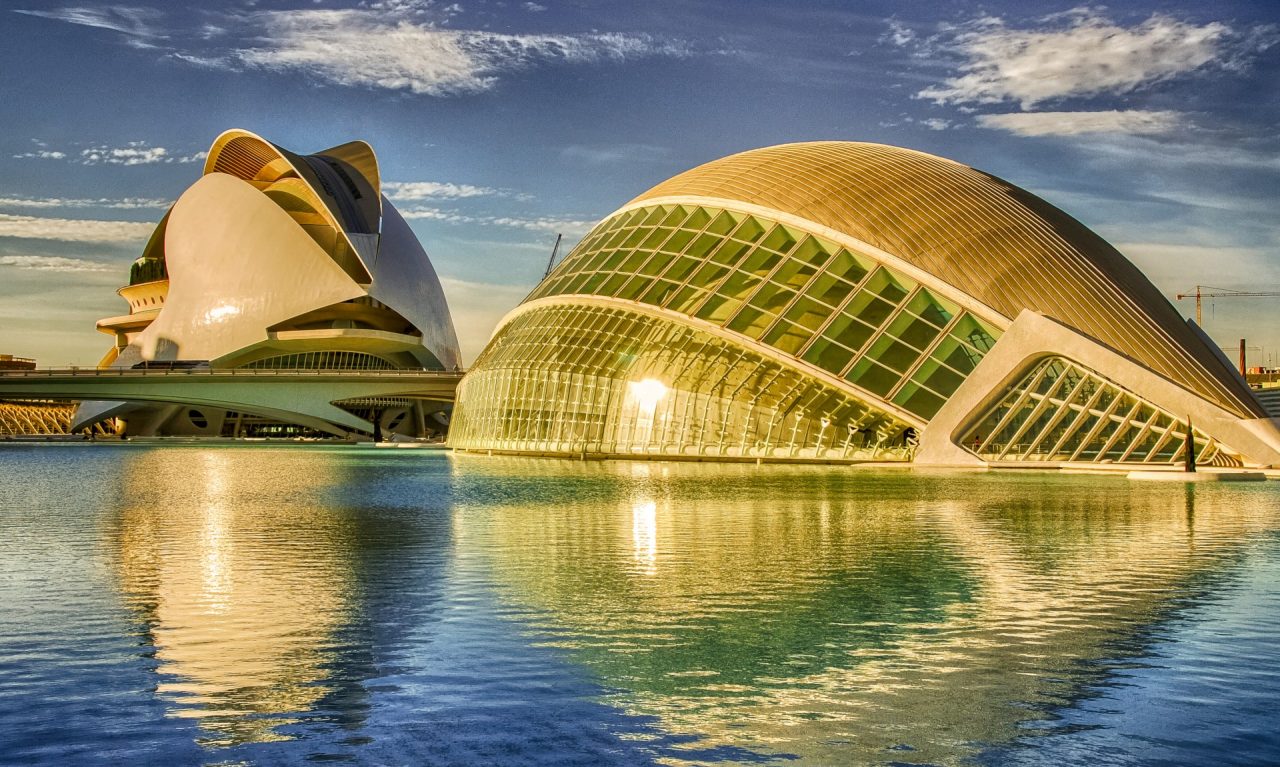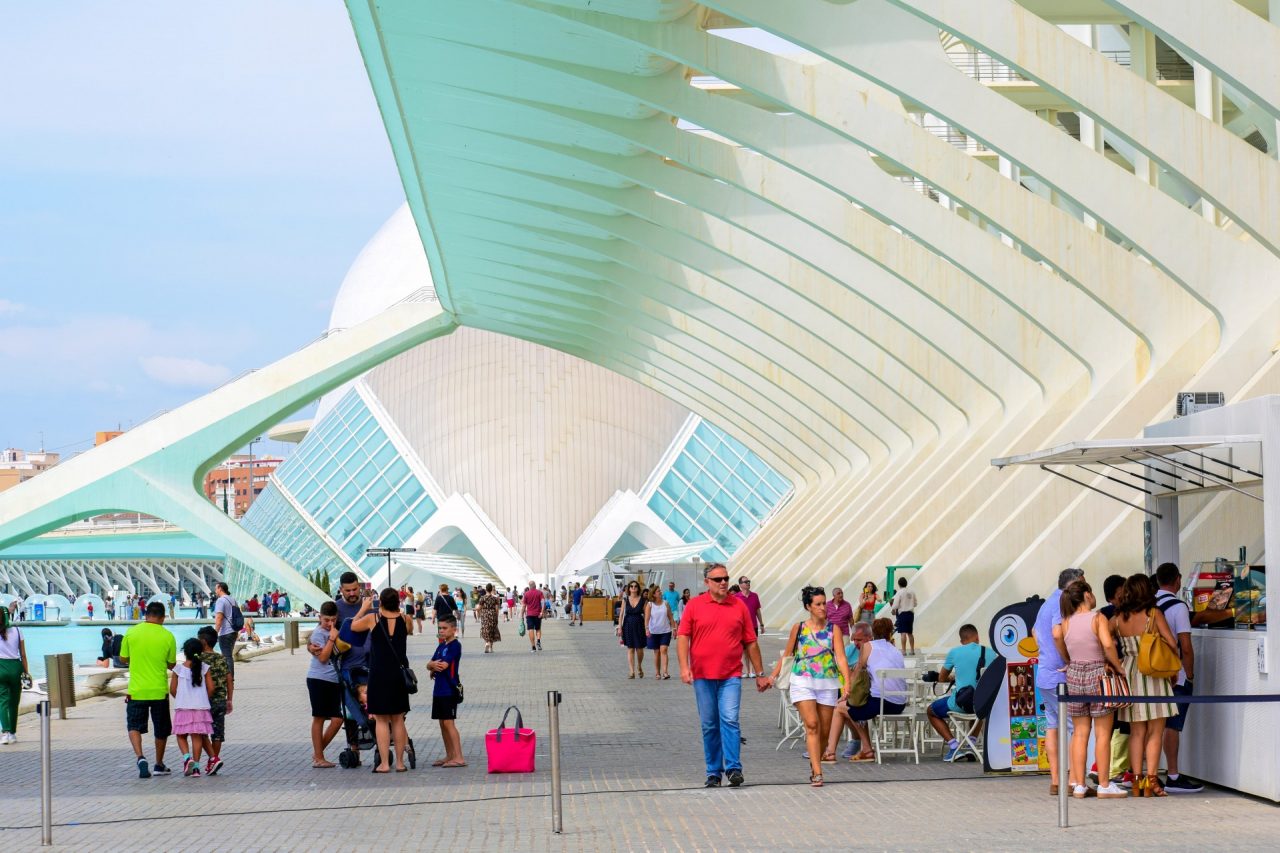Transform an abandoned industrial area into a vibrant new urban attraction. Requalify an entire district that time and neglect had demoted to a warren of warehouses near the city’s port. Re-purpose the former bed of a river that was diverted in the 1950s to avert the risk of dangerous flooding.
Behind the beauty and artistic value of the City of Arts and Sciences of Valencia, there is the story of an ambitious urban redevelopment project, which shows how cities around the world can rewrite their destinies in the name of sustainability and quality of life.
This was the goal of architect Santiago Calatrava when he designed the City of Arts and Sciences in Valencia, an incredible destination completed in 2009 that occupies an area of 350,000 square meters (418,000 square yards).
This “city within a city” has become a global tourist attraction, but also for scientific scholars and architecture enthusiasts, and has put Valencia on the world map.
This was Calatrava’s intention from the start. The architect was born in Valencia and is known throughout the world for his innovative buildings, characterized by white as the dominant color and sinuous, modern shapes.
The City of Arts and Sciences is perhaps the best example of Calatrava’s architectural vision because it combines the beauty of form with structural grandeur. The park stands on the former bed of the Turia River, not too far from the sea. It is divided into five areas within which you can do almost anything: attend an opera performance, listen to music, visit a museum, be fascinated by the largest aquarium in Europe, or even just stroll in the Umbracle, the huge garden that surrounds the City.
Style and Construction of the City of Arts and Sciences
The City of Arts and Sciences is not just the brainchild of a great architect. It is also a complex and innovative work of infrastructure. To understand its economic impact on the city of Valencia, in 2019 the local government calculated that each year the structure ensures a turnover of €113 million by employing 3,509 people.
The idea for the project came to the president of the Autonomous Government of Valencia, Joan Lerma, in 1989 after a visit to the City of Science and Industry in Paris.
The first draft of the design was commissioned in 1990 at a cost of €556,000, in collaboration with the University of Valencia, while the final design was presented by Santiago Calatrava in May 1991.
Commissioned in 1996 for an initial €300 million, the work was intended to become a symbol of the city like the Guggenheim Museum in Bilbao, designed by architect Frank Gehry. And that is exactly what happened — even though its budget grew disproportionately to €1.2 billion during construction.
After the Turia River overflowed in the catastrophic flood of 1957, the course of the river was diverted, creating a 1-kilometre (0.62-miles) area that became the ideal place to build a large international park.
Its construction, however, was fraught with problems. Work began in July 1996 and the first building, the Hemisphere, was inaugurated on April 16, 1998. However, it took twenty years to complete the entire project. The last parts of the structure to see the light were the Queen Sofia Palace of Arts, inaugurated on October 9, 2005, and the Agorà, which finally opened in 2009.
The buildings that make up the architectural complex
The Queen Sofia Palace of Arts
This is the largest building in the architectural complex designed by Santiago Calatrava, and houses the Valencia Opera House. The initial project called for a telecommunications tower. The architect then changed it by designing a 70-meter-high (229 feet) structure that resembles the human skull and that is used exclusively for performance of music, theater, and dance.
Just like the Auditorium Parco della Musica in Rome and the Stavros Niarchos Foundation Cultural Center in Athens, both built by the Webuild Group, this structure focuses on beauty as the best way to express the arts.
Hemisphere and the Science Museum
The Hemisphere has a shape inspired by the human eye and is reflected by a lake measuring 24,000 square meters (28,000 square yards). Inside the facility is a cinema with a 900-square-metre (1,076-yard) screen, and a globe-shaped planetarium. The facility also houses a library, a restaurant and another auditorium.
The Prince Philip Museum of Science and Technology, on the other hand, resembles the shape of a wave for some, and the skeleton of a whale for others. The entire structure overlooks the water through a long glass gallery.
The museum hosts technological and scientific exhibitions: 40,000 square meters (47,800 square yards) divided on three floors dedicated to a direct experience of human knowledge.
The Agorà and the Oceanographic Museum
The Agorà is the last building in the large complex envisioned by the architect Calatrava. Its function is to represent a large covered square with an elliptical shape serving a wide variety of needs, from sporting events to theatrical performances to film screenings.
Not too far from the Agorà stands the Oceanographic Museum, the largest open air oceanographic aquarium in Europe where you can admire the planet’s various marine ecosystems: 45,000 specimens belonging to 500 different underwater species that live in 9 different areas of the planet. The roof of the Oceanogràfic, unlike the rest of the structure, was designed by architect Felix Candela.

Valencia and its infrastructure
The City of Arts and Sciences has become a symbol for Valencia, a lively and modern city and one of the largest in Spain.
The former riverbed of the Turia River, where the City now stands, is a key element in the infrastructural history of this city. The issue — still a problem today – is that the water infrastructures of the city is inadequate to cope with its geography and the droughts and copious rainfall that affects the region. The latest catastrophe when Storm Gloria hit the city in December 2019 and early 2020, causing extensive damage.
To understand the impact of these phenomena on the city, the EIB (European Investment Bank) allocated €100 million in September for the Valencian Region to restore the damage caused by the recent floods. In addition to creating more effective infrastructure against flooding, the investments will create 1,500 jobs by 2025.
“The Valencia Region will see an increase in droughts and periods of torrential rain, as well as higher temperatures and rising sea levels. Investments in greater climate resilience will therefore be a priority in the coming years, in line with the recovery plan,” said Finance Minister Vicent Soler.
The future: City of Science is still not finished
After 20 years of work, the City of Arts and Sciences still doesn’t seem to be finished. Just this year, the city administration announced the construction of the CaixaForum Valencia, a new structure that will be built in the spaces where Calatrava’s complex stands. According to the plan, the building will be used as a cultural center, with a surface area of 6,500 square metres (69,000 square feet), comprised of two large exhibition halls and an auditorium that can accommodate 300 people.
The CaixaForum calls for an investment of €19 million and will take two years to complete, demonstrating that the process of urban regeneration that Valencia embarked on two decades ago is not yet finished.


